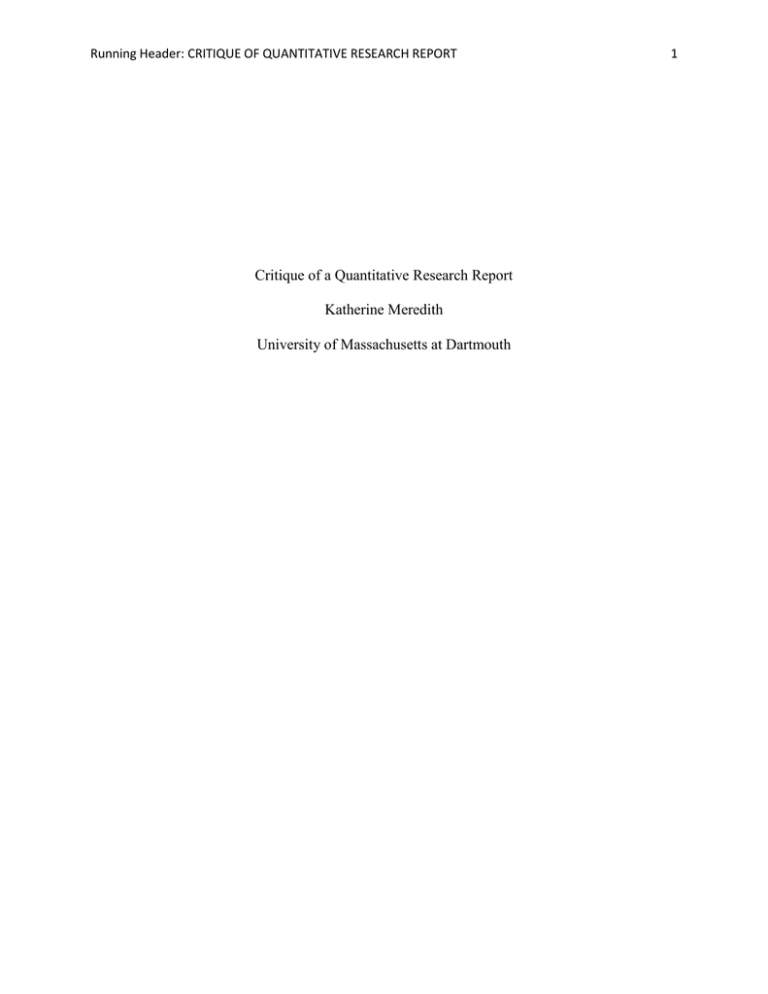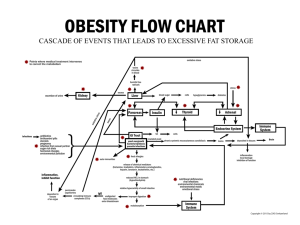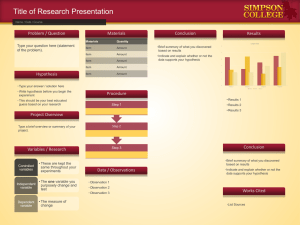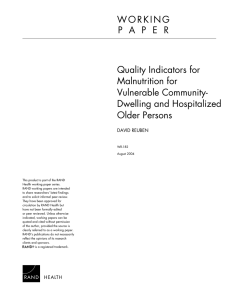research critique
advertisement

Running Header: CRITIQUE OF QUANTITATIVE RESEARCH REPORT Critique of a Quantitative Research Report Katherine Meredith University of Massachusetts at Dartmouth 1 2 Introduction: The purpose of this paper is to critique a publicly dissertated scholarly article, and to assess what aspects of research, reviewed in the class Scholarly Inquiry 214, were applied. These aspects include many categories such as: purpose and problem statement, review of literature, research question/ hypothesis, research design, sample and setting, data collection, and study results. This critiqued article’s title is very concise and clear as to the content of the study. The title describes the population examined (in this case, “older adults”) and the variables (nutritional status, and clinical impact of infections.) In this paper, rather than titling an abstract section, they instead used an “Objectives” titled section to explain the study. The summery in the Objective section was concise and clear about the purpose and variables, as well as the population. Purpose and Problem Statement: A purpose statement is used to describe why a study has been conducted. For this paper, the purpose statement was put at the very end of the first section. The purpose statement was: “The present study was designed to determine the effects of a food intervention and micro nutrient supplements with levels that are realistically achievable by food alone on self-reported infection nutritional status, and immune functions in community living older adults.” This stamen not only identifies all three variables, the population assessed in this study. Problem statements justify why the research is being done. In this report the problem statement was not distinct, but rather spread about inconclusively within a couple of sentences. The problem statement appeared to be as followed: “decline in immune function and… susceptibility of elderly adults to disease… is a major contributor of morbidity and mortality in 3 this age group…Improving nutritional status might attenuate the impairment of immune function associated with old age.” This statement although not concise, does provide validation for the importance of the study. It addresses the fact that a decline in immune function and presence of disease is a significant problem in the elderly population making it a “major contributor of mortality” in the elderly population. This statement also suggests that improving nutritional status may help with immune functioning. This research study is justified as it provides an actual problem a certain population faces and a potential alleviation options to elicit improvement. Review of Literature: There was no designated portion of the piece dedicated to a literature review. Instead it was placed in the beginning paragraph of the report and later in the discussion section. All of the cited literature was directly related to the study. Some pieces focused on the correlation of disease and mortality, and some on the effects of nutrition, and certain supplement on health. Most of the literature reviewed in the article would not be considered “current” (within 5-7 years of publication.) This article was published in 2012, however, most of the research cited was from the 1990’s, and there were five from 1980, the oldest cited was from 1981. Some of the pieces of literature that were reviewed critically addressed the variables presented. For example, there were six studies cited suggesting that “single nutrient supplements of Vitamin E, beta carotene, zinc, and selenium may enhance some aspects of immune function in older adults”. There were two studies addressing the suggestion that poor nutrition may increase the susceptibility to infection. However, in all the in text citations of these articles, they did not critique the studies, or verify their validity. The literature review does reveal discrepancies of knowledge between nutrition and infections. “Few studies have attempted to modulate immunity in elderly adults 4 using food or physiological doses of nutrients.” A majority of the sources used in this study were primary. A primary study is defined as a study that is reported by the person who conducted the research, or developed the theory. When reviewing the literature, when discussing infection in older adults it is stated that: “Although the mechanisms leading to this decline are poorly understood, evidence indicates that improving nutritional status might attenuate the impairment of immune function associated with old age.” Earlier in the paragraph it mentions that diseases caused from infections are a “major contribute to morbidity and mortality” in the older population. As mentioned before this justifies the importance of this study. A conceptual model is a set of concepts, both abstract and general that are gathered in an attempt to describe a phenomenon. The aspects of the conceptual model of this study were: QOL (quality of life), hospital visits, GP (general practitioner) visits, biochemical analysis, depression, and weeks in which illness affected life. This study had an expansive list of concepts of which further studies could be conducted from. It also provides a good framework for the study to look at problems and develop and test hypotheses. Research question/ Hypothesis: A hypothesis is a suggested relationship between two variables. This study aimed to assess a relationship. However, there was no definitive hypothesis stated. A research question is a concise interrogative sentence that includes one or more variable. In this study the research question was to study the: “effects of a food intervention and micronutrient supplements with levels that are realistically achievable by food alone on self-reported infection, nutritional status, and immune function in community-living older adults.” It matches the purpose of the study, and is clearly worded and testable. This is a complex hypothesis, as it discusses more than one 5 independent and dependent variables. It is a non-directional hypothesis as it does not specify a direction in which the correlation between the variables is expected to go. Research Design: The type of research design used in this study is middle range theory. A middle range theory is defined as research looking at a piece of reality that contains variables that are specified in nature and direction. This would be applied research, because it gains knowledge that can be used in practice, and was conducted under normal conditions. For example, subjects in this study slightly altered a small portion of their life, but otherwise remained living in their “normal conditions” It was experimental research because a variable was changed to observe an outcome. It was prospective, taking in new data, rather than looking at old charts, and it was longitudinal because the data was gathered over a period of time. The period of time in the case of this study was 6 months. Internal validity looks as to whether or not the independent variable made a difference in the outcome. Internal validity can be threatened by extraneous variables. Examples of extraneous variables for this could include subjects who had: previous hospitalizations, mal-absorption, gastrointestinal disease, or those who had a psychiatric illness. There are more outlined in the section “Recruitment and Inclusion Exclusion Criteria.” Those who fell into these categories were then excluded from the study to preserve internal validity. The independent variables of this study were micronutrient supplement as well as dietary intervention. The dependent variable of this study was the clinical impact of infections (although there are many categories that fall under this broad spectrum.) Although the “methods” section of this report does not give a detailed enough overview to repeat this exact experiment, it lists a link to follow for more 6 information. It does however, describes the whole population base and lists the exact micronutrients given in the supplement. However, no explicit information was given in regards to the dietary information.







